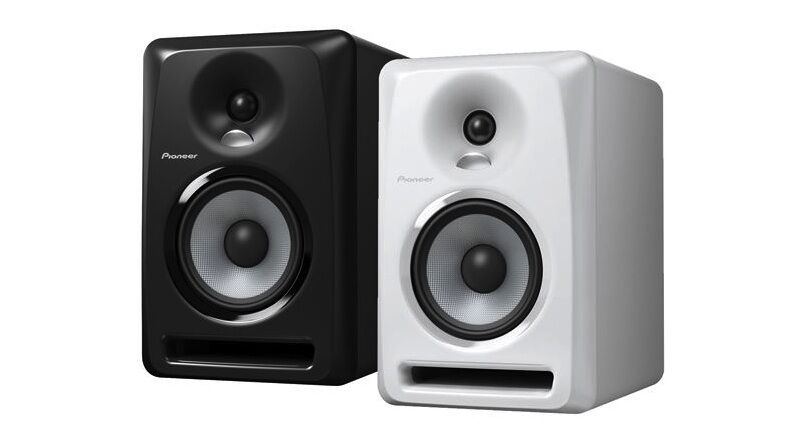The Lowdown
With some of the thinking of dedicated studio monitors, and dash of pzazz from the nightclub world, the Pioneer S-DJ50X monitors have a lot going for them for the DJ/producer market they’re aimed at.
Video Review
First Impressions / Setting up
Made to the same high standards as the bigger speakers in the range, these are sober, black wooden cabinets, with a pleasing curve on the front. They’re basically very KRK-esque but with white instead of yellow cones. They are appreciably deep, and feel well made. There is a large square foam layer glued to the underside of each unit, making it grippy on most surfaces.
They are bi-amped, independent speakers in the sense that you buy two identical units to make up your stereo pair, and feed one half of your stereo signal into each. They have RCA, plus balanced TRS & XLR inputs, and they also have a volume control, a treble trim, a useful auto standby switch (powering them down until they “hear” music) and… that’s about it. In true studio monitor style, they’re pretty minimalist.
In Use
So I’ve tested all three pairs over the last few months, and as the smallest, with 5″ woofers, you’d expect these to deliver less fullness than the rest. It’s true, but they’re a very nicely balanced speaker nonetheless. Tested with a Vestax VCI-380 and Serato DJ, 320mbps MP3s sounded full, warm, bassy and articulate, and I have to say that in the relatively small test room we have here, the 50s suited it better than the 80s, and arguably as well as the 60s.
The treble control is really just designed to match the high frequencies to your room; it is in no way, shape or form designed as a “tone” control, that being the domain of your DJ controller or mixer. I found in the rather bright room we tested them in that putting it one “stop” below zero sounded fine. More dynamic EQing is definitely not something you’d expect to find on powered monitors, and so it is here.
I’ll also be completely honest about how I tested these: I tested them with DJ gear, as a DJ, which is what I believe they’re intended to be used for. Our room isn’t set up for production, and I’d do things a lot differently in here if it were; what I will say is that for DJing, including mashing up, re-editing, and all the other things us DJs do to give ourselves the unique music libraries we crave, and then squeeze the most out of those libraries in our sets, the S-DJ50Xs hit the spot. I’d compare them closely to the KRK Rokit RP5 G3, a speaker we also rate highly.
Conclusion
Are you a DJ looking for something better than you’ve got now? Fancy yourself as a bit of a DJ/producer? Already got (or aspire to) some type of Pioneer gear? Find your current speakers aren’t coping with the volume levels you’re throwing at them? Then the S-DJ50Xs should be on your list. Especially if you’re in a small to medium-sized room, you really don’t need anything bigger. Sure, they sacrifice some of the fullness of bigger speakers, but they still sound mighty fine – and they’re practical to boot. Make no mistake – these may be the smallest of three in the range, but they’re not really “compact”, as they’re deep, heavy and have a big, fat front port for the bass to pump out of. They’re still a seriously loud speaker.
I have to say at this point that Pioneer’s promo video shows some hipster dude carting these underarm to a party. No matter what speakers you have, you don’t want to do that, and especially if they have exposed cones like these (and practically all monitors) do. Say it until you believe it: You’re going to wreck them! Also, higher up in Pioneer’s own range and with cheaper competitors like Reloop (I’m thinking the Reloop Waves or the Pioneer S-DJ05/8s) you can get truly handy linking of a pair of speakers plus remote control, both of which make use in a busy, multi-input home studio or practice room more practical. Nothing like that here.
But for a minimal, good quality, loud and decent looking DJ speaker, the Pioneer S-DJ50X hits the mark. Have it on your list and get a listen if you can – speaker choice is an intensely personal thing and one man’s perfect is a another’s so-so. For us, they tick plenty of boxes, albeit with nothing to really make them stand out hugely from the pack.


